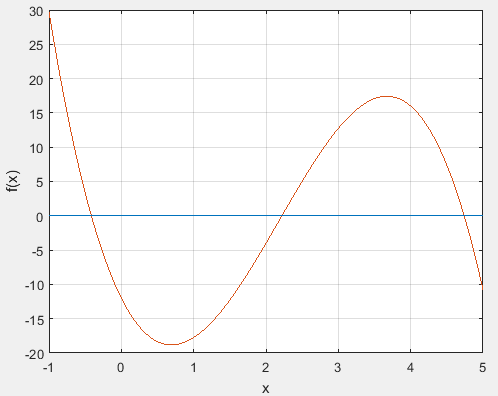
Determine the roots of
(a)
To calculate: The real roots of the equation
Answer to Problem 4P
Solution: Graphically, the real roots of the equation are approximated as
Explanation of Solution
Given Information: The equation
Formula used: The roots of an equation can be represented graphically by the x-coordinate of the point where the graph intercepts the x-axis.
Calculation:
Use the following MATLAB code to plot the function
Execute the above code to obtain the plot as,

From the plot, the zeros of the equation are approximated as
(b)
To calculate: The root of the equation
Answer to Problem 4P
Solution: The root of the equation is approximated as
Explanation of Solution
Given Information: The function equation is
Initial guesses are,
Formula used: A root of an equation can be obtained using the bisection method as follows:
1. Choose two values of x, say a and b such that
2. Estimate the root by
3. If,
Calculation:
For the function
Thus,
Calculate the first root to be,
Further,
Thus,
Calculate the second root to be:
The approximate error is computed as:
Therefore, the approximate relative percentage error is 100%.
Furthermore,
Thus,
Calculate the third root to be:
The approximate error is computed as:
The approximate error is 33.3%.
Further,
Thus,
Calculate the fourth root to be:
The approximate error is computed as:
The approximate error is 14.28%.
Thus,
Therefore,
Calculate the fifth root to be:
The approximate error is computed as:
The approximate error is 7.69%.
Thus,
Therefore,
Calculate the sixth root to be:
The approximate error is computed as:
The approximate error is 3.7%.
Thus,
Therefore,
Calculate the seventh root to be:
The approximate error is computed as:
The approximate error is 1.89%.
Further,
Thus,
Calculate the eighth root to be:
The approximate error is computed as:
The approximate error is 0.93%.
As,
(c)
To calculate: The root of the equation
Answer to Problem 4P
Solution: The root of the equation can be approximated as
Explanation of Solution
Given Information: The equation
Initial guesses are,
Formula used: A root of an equation can be obtained using the false-position method as follows:
1. Choose two values of x, say a and b such that
2. Estimate the root by
3. If,
Calculation:
For the function
Thus,
Calculate the first root to be,
Now,
Thus,
Calculate the second root to be:
The approximate error is computed as:
The approximate relative percentage error is 24.25%.
Further,
Thus,
Calculate the third root to be:
The approximate error is computed as:
The approximate error is 6.36%.
Now,
Thus,
Calculate the fourth root to be:
The approximate error is computed as:
The approximate error is 1.68%.
Now,
Thus,
Calculate the fifth root would be:
The approximate error is computed as:
The approximate error is 0.45%.
As,
Want to see more full solutions like this?
Chapter 5 Solutions
NUMERICAL METH. F/ENGR.(LL)--W/ACCESS
Additional Math Textbook Solutions
Fundamentals of Differential Equations (9th Edition)
Basic Technical Mathematics
Advanced Engineering Mathematics
An Introduction to Mathematical Statistics and Its Applications (6th Edition)
Geometry For Enjoyment And Challenge
 College AlgebraAlgebraISBN:9781305115545Author:James Stewart, Lothar Redlin, Saleem WatsonPublisher:Cengage LearningAlgebra & Trigonometry with Analytic GeometryAlgebraISBN:9781133382119Author:SwokowskiPublisher:Cengage
College AlgebraAlgebraISBN:9781305115545Author:James Stewart, Lothar Redlin, Saleem WatsonPublisher:Cengage LearningAlgebra & Trigonometry with Analytic GeometryAlgebraISBN:9781133382119Author:SwokowskiPublisher:Cengage
 Algebra: Structure And Method, Book 1AlgebraISBN:9780395977224Author:Richard G. Brown, Mary P. Dolciani, Robert H. Sorgenfrey, William L. ColePublisher:McDougal Littell
Algebra: Structure And Method, Book 1AlgebraISBN:9780395977224Author:Richard G. Brown, Mary P. Dolciani, Robert H. Sorgenfrey, William L. ColePublisher:McDougal Littell Algebra and Trigonometry (MindTap Course List)AlgebraISBN:9781305071742Author:James Stewart, Lothar Redlin, Saleem WatsonPublisher:Cengage Learning
Algebra and Trigonometry (MindTap Course List)AlgebraISBN:9781305071742Author:James Stewart, Lothar Redlin, Saleem WatsonPublisher:Cengage Learning




